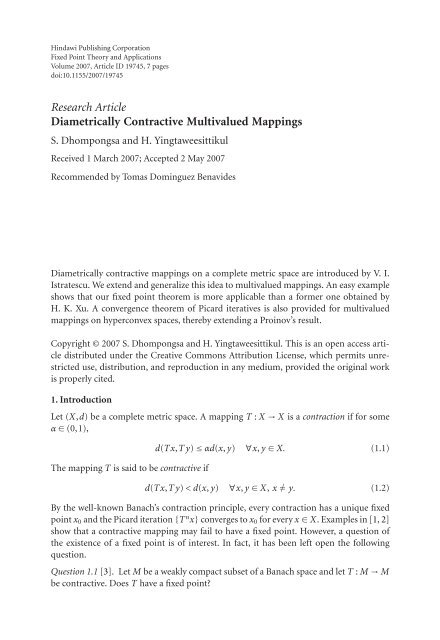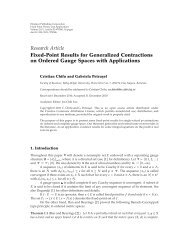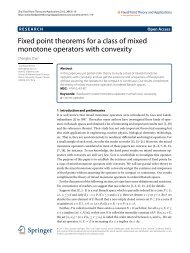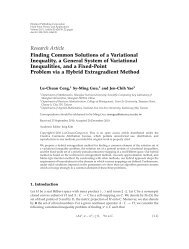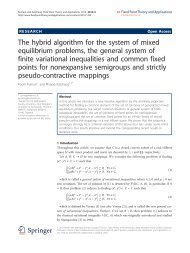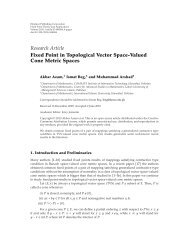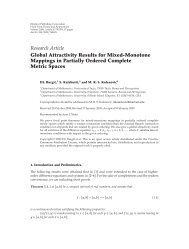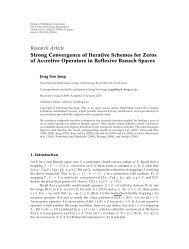Diametrically Contractive Multivalued Mappings
Diametrically Contractive Multivalued Mappings
Diametrically Contractive Multivalued Mappings
Create successful ePaper yourself
Turn your PDF publications into a flip-book with our unique Google optimized e-Paper software.
Hindawi Publishing Corporation<br />
Fixed Point Theory and Applications<br />
Volume 2007, Article ID 19745, 7 pages<br />
doi:10.1155/2007/19745<br />
Research Article<br />
<strong>Diametrically</strong> <strong>Contractive</strong> <strong>Multivalued</strong> <strong>Mappings</strong><br />
S. Dhompongsa and H. Yingtaweesittikul<br />
Received 1 March 2007; Accepted 2 May 2007<br />
Recommended by Tomas Dominguez Benavides<br />
<strong>Diametrically</strong> contractive mappings on a complete metric space are introduced by V. I.<br />
Istratescu. We extend and generalize this idea to multivalued mappings. An easy example<br />
shows that our fixed point theorem is more applicable than a former one obtained by<br />
H. K. Xu. A convergence theorem of Picard iteratives is also provided for multivalued<br />
mappings on hyperconvex spaces, thereby extending a Proinov’s result.<br />
Copyright © 2007 S. Dhompongsa and H. Yingtaweesittikul. This is an open access article<br />
distributed under the Creative Commons Attribution License, which permits unrestricted<br />
use, distribution, and reproduction in any medium, provided the original work<br />
is properly cited.<br />
1. Introduction<br />
Let (X,d) be a complete metric space. A mapping T : X → X is a contraction if for some<br />
α ∈ (0,1),<br />
The mapping T is said to be contractive if<br />
d(Tx,Ty) ≤ αd(x, y) ∀x, y ∈ X. (1.1)<br />
d(Tx,Ty)
2 Fixed Point Theory and Applications<br />
Istratescu [4] introduced a proper subclass of the class of the contractive mappings,<br />
whose elements are called the diametrically contractive mappings. Xu [2] proved,inthe<br />
framework of Banach spaces, the following theorem.<br />
Theorem 1.2 [2, Theorem 2.3]. Let M be a weakly compact subset of a Banach space X<br />
and let T : M → M be a diametrically contractive mapping. Then T has a fixed point.<br />
The following problems raised in [2] had been answered in the negative way in [5].<br />
Problem 1.3. Can we substitute “weakly compact” subset with “closed convex bounded”<br />
one in Theorem 1.2?<br />
Problem 1.4. If T is diametrically contractive and x ∗ is the fixed point of T, dowehave<br />
T n x → x ∗ forall(oratleastforsome)x ∈ M?<br />
In this paper, we weaken the condition in the definition of diametrically contractive<br />
mappings and obtain a corresponding fixed point theorem for nonself multivalued mappings.<br />
Moreover, we also apply a Proinov’s fixed point theorem to a selection of a multivalued<br />
mapping with externally hyperconvex values and obtain its unique fixed point on<br />
a hyperconvex metric space.<br />
2. <strong>Diametrically</strong> contractive mappings<br />
In [4], Istratescu introduced a new class of mappings strictly lying between contractions<br />
and contractive mappings.<br />
Definition 2.1. AmappingT on a complete metric space (X,d)issaidtobediametrically<br />
contractive if δ(TA)
S. Dhompongsa and H. Yingtaweesittikul 3<br />
Put A0 = TA∩ A w . Therefore A0 = TA∩ A w ⊂ TA∩ M w ⊂ A w = A and so A0 ⊂ A.<br />
Moreover, we have TA0 ∩ M ⊂ TA∩ M ⊂ A. Therefore TA0 ∩ M ⊂ TA∩ A ⊂ TA∩ A w =<br />
A0.ThusA0 ∈ and by maximality of A,wehaveA = A0 = TA∩ A w .Bylowersemicontinuity<br />
of the norm of X we see that δ(A) = δ(TA∩ A w ) = δ(TA∩ A). Since T is diametrically<br />
contractive we must have δ(A) = 0andA consists of exactly one point, say ξ. By<br />
the condition ∅ = TA∩ M ⊂ A we see that ξ ∈ Tξ, and we have a fixed point. <br />
The proof given above is a modification of the proof of Theorem 1.2. The following<br />
example shows that Theorem 2.2 is strictly stronger than Theorem 1.2.<br />
Example 2.3. M = [0,5], T : M → R defined by Tx = x +1ifx ≤ 3, and Tx = 4ifx>3.<br />
Now, if A is a closed subset of M, then there will be a, b in M such that A ⊂ [a,b] and<br />
δ(A) = b − a. If[a,b] ⊂ [0,3], then TA ⊂ [a +1,b +1] and TA ∩ A ⊂ [a +1,b]. Thus<br />
δ(TA∩ A) ≤ b − a − 1
4 Fixed Point Theory and Applications<br />
Theorem 2.6 [7, Theorem1]. Let (X,d) be a complete metric space and let M be a nonempty<br />
bounded nearly subadmissible subset of X.IfT ∈ KKM(M,M) is a k-set contraction,<br />
0 ɛ such that ɛ
S. Dhompongsa and H. Yingtaweesittikul 5<br />
3. Picard iteratives for multivalued mappings on hyperconvex metric spaces<br />
Ametricspace(X,d)ishyperconvex if for any family of points {xα} in X and any family of<br />
positive numbers {rα} satisfying d(xα,xβ)≤rα+rβ,wehave <br />
α B(xα,rα) =∅where B(x,r)<br />
is the closed ball with center at x and radius r. AsubsetEof X is said to be externally<br />
hyperconvex if for any of those families {xα}, {rα} with d(xα,xβ) ≤ rα + rβ and dist(xα,E) ≤<br />
rα,wehave <br />
α B(xα,rα) ∩ E =∅. The class of all externally hyperconvex subsets of X will<br />
be denoted by (X). Let H be the Hausdorff metric.<br />
Let t be a single-valued selfmapping on a metric space (X,d). A fixed point of t is<br />
said to be contractive (cf. [9]) if all Picard iteratives of t converge to this fixed point.<br />
A selfmapping t on a metric space (X,d) issaidtobeasymptotically regular (cf. [10])<br />
if limd(t n (x),tn+1 (x)) = 0foreachx in X. Extend the concept naturally to multivalued<br />
mappings with the Hausdorff metric taken into action.<br />
Theorem 3.1 [8, Theorem 4.1]. Let t be a continuous and asymptotically regular selfmapping<br />
on a complete metric space satisfying the following conditions:<br />
(i) there exists ϕ ∈ Φ1 such that d(t(x),t(y)) ≤ ϕ(D(x, y)) for all x, y ∈ X;<br />
(ii) d(t(x),t(y))
6 Fixed Point Theory and Applications<br />
Put rk = ϕ(d(xk−1,xn)), and rt(x) = ϕ(d(x,xn)) for each 1 ≤ k ≤ n, andforallx ∈ A.<br />
Thus, for 1 ≤ k ≤ n, x ∈ A,andfori
S. Dhompongsa and H. Yingtaweesittikul 7<br />
[10] F. E. Browder and W. V. Petryshyn, “The solution by iteration of nonlinear functional equations<br />
in Banach spaces,” Bulletin of the American Mathematical Society, vol. 72, pp. 571–575, 1966.<br />
S. Dhompongsa: Department of Mathematics, Faculty of Science, Chiang Mai University,<br />
Chiang Mai 50200, Thailand<br />
Email address: sompongd@chiangmai.ac.th<br />
H. Yingtaweesittikul: Department of Mathematics, Faculty of Science, Chiang Mai University,<br />
Chiang Mai 50200, Thailand<br />
Email address: g4825119@cm.edu


